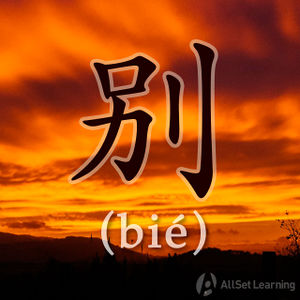Difference between revisions of "Negative commands with "bie""
m (Text replacement - "shíhòu" to "shíhou") |
|||
| Line 9: | Line 9: | ||
<div class="jiegou"> | <div class="jiegou"> | ||
| − | 别 + Verb + ( | + | 别 + Verb + (Obj.) |
</div> | </div> | ||
Revision as of 06:03, 23 September 2015
-
Level
-
Similar to
-
Used for
-
Keywords
This is one of the few times that Chinese language seems to have a "contraction." Instead of saying "do not," we can say "don't" by using 别 (bié).
Structure
As well as 不要 (bùyào), negative commands can also be formed with 别 (bié). You could think of 别 (bié) as a contraction of 不要 (bùyào), as the structure is the same for both:
别 + Verb + (Obj.)
Examples
- 别 走。Don't go.
- 别 说话!Don't speak!
- 别 生气!Don't get mad!
- 别 笑!Don't laugh!
- 别 喝 太 多 酒。Don't drink too much alcohol.
- 喝 酒 以后 别 开车。After drinking alcohol, don't drive.
- 吃饭 的 时候 别 看 电视。When eating, don't watch TV.
- 别 哭。Don't cry.
- 别 跟 我 说 英文。Don't speak English with me.
- 小心,别跑!Be careful, don't run!
See also
Sources and Further Reading
Videos
- Yoyo Chinese: Negative commands



